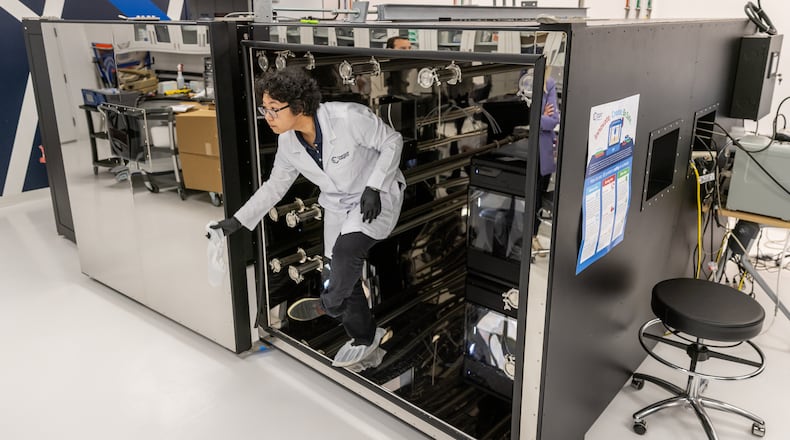Not so long ago, the concept seemed fanciful: take an idea, draw it on a screen, then print it into three-dimensional reality.
But 3D printers, once a novelty, are becoming more common in schools and homes, and that is concerning for some pollution researchers who’ve been studying them.
These fused filament fabrication devices “have been shown to emit copious amounts of ultrafine PM (particulate matter) in office spaces, homes, and a classroom as well as in controlled laboratory studies,” says a National Academy of Engineering report on indoor air pollution published earlier this year.
“It’s melting plastic at relatively high temperatures, which is going to do two things. It’s going to emit gases and it’s going to emit particles,” said Brent Stephens, an Illinois Institute of Technology engineering professor and indoor air quality expert who helped write a portion of that report.
Some metro Atlanta school districts and parents are aware there could be a risk but not necessarily about the volume of research nor the level of concern raised by experts.
Marilyn Black, a chemist who has co-authored many research papers on the topic, said close proximity to a cheaper, higher-emitting machine could expose one to pollution levels that exceed national outdoor air quality standards.
“It would be equivalent basically to sitting beside a freeway with diesel trucks coming up and down,” she said.
Black leads a Marietta-based nonprofit research arm of the for-profit safety standards company, Underwriters Laboratories Inc. UL founded its Chemical Insights Research Institute about a decade ago, when 3D printers were becoming more common. It was around then that some school districts called, wondering about the smells from their 3D printers, and about the potential effect on asthmatic students. So they looked into it.
Her team has identified around 500 chemicals, she said. “Some of the levels may not be high enough to cause an immediate reaction. But if you get what we call more of the chronic long-term exposure, that starts to add up and that’s what you want to prevent,” Black said. Her organization has produced a guide to help schools reduce exposure to 3D printer emissions.
Last year, UL also collaborated with the Campus Safety, Health, and Environmental Management Association to provide UL 200B, a guidance document for safe 3D printer use in higher education settings. There is no such coordination at the K-12 level though.
Credit: Steve Schaefer /
Credit: Steve Schaefer /
Both the Georgia Department of Education and the state Department of Public Health told The Atlanta Journal-Constitution that they have issued no guidance on 3D printers. The Centers for Disease Control and Prevention offers some advice, such as purchasing a printer that has a built-in filtration system capable of removing both small particles and gases.
A week after the AJC inquired, several school districts in metro Atlanta had not produced a count of the devices on their campuses. But the Cherokee County School District tallied 80 of them, noting that their recent practice has been to purchase only enclosed units to contain contaminants. Teachers are supposed to follow the manufacturer’s safety guidelines.
Gwinnett County, the state’s largest school system, has 76 Stratasys 3D printers, a higher-end product that comes with a built-in HEPA filtration system to control emissions. (Black’s group is now studying how well such filtration systems work.) The district said in a statement that it places them in large, well-ventilated areas.
“With that said, GCPS was recently made aware of new studies evaluating 3D printer emissions and any potential risks they pose,” the district added. “Like our peers in education and the business world, GCPS is monitoring these studies and awaiting any potential new guidance from state and federal regulators.”
Fulton County Schools officials said in a statement that most of their printers are equipped with an air filter. In middle and high school labs, they are “closed off” from other classrooms to mitigate potential emissions.
Those would be more expensive than the 3D printers one can find for under $200. Black said she’d seen an unenclosed printer running in a metro Atlanta second grade classroom, and another in a middle school janitorial closet.
Jeffrey Siegel, a professor of civil engineering at the University of Toronto, said schools should isolate their 3D printers in an enclosure and exhaust the emissions through a hose through the wall. Or they should at least run them in a vacant room with the windows open. Experts also say nearby surfaces should be wiped clean of dust that might contain heavy metals, such as arsenic and lead.
”At this point, there really is a ton in the literature on these printers,” said Siegel, an expert on indoor air quality. “There are definitely emissions of concern, so you’ve got to deal with it.”
Christina Hodgen, a parent of two young kids in the Atlanta Public Schools, is married to a computer programmer with a background in electrical engineering. He bought a higher-end 3D printer build-your-own kit, which they operate in a drafty basement. He thought he had researched all the health angles, but after the AJC shared some of the research by Black and her colleagues, Hodgen said her husband was thinking about installing a venting system.
She’s also concerned about the 3D printers in her son’s middle school, which she said operate near the school library unvented. She wants students to have access to the devices, but she plans to inquire about safety protocols.
“People need to know, and it’s becoming more prevalent,” she said. “I think we were probably the first one around this neighborhood that had one, and after that, you hear more and more kids asking for them for Christmas.”
About the Author
Keep Reading
The Latest
Featured



